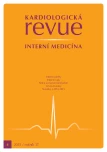Prescribing antibiotic treatment in patients on renal replacement therapy
Authors:
O. Zakiyanov; J. Vachek; V. Tesař
Authors‘ workplace:
Klinika nefrologie 1. LF UK a VFN v Praze
Published in:
Kardiol Rev Int Med 2015, 17(4): 342-344
Category:
Cardiology Review
Overview
When renal function is impaired, any drug which is excreted by the kidney will be retained in the body. Continued administration of certain drugs may result in abnormally high blood levels and dangerous side-effects. However, specifically in the case of antibiotics, we must also consider the risk associated with doses that are too low, which may be more threatening for patients suffering from severe infections than the risk of adverse effects. When managing antibiotic treatment, we must take into account certain factors about the patient (e. g. severity of the infection, status of the immune system), the impact of the renal replacement therapy (type of dialysis and dialysis membrane, duration and frequency of dialysis sessions), and the characteristics of the drug (dialysability, drug lipophilicity, nephrotoxicity, organ toxicity). Determining the risk-benefit ratio always compels an individualised approach. Helpful tools include peak and trough drug levels measurement (Therapeutic Drug Monitoring – TDM) and co-operation between the attending physician and the nephrologist, clinical pharmacist, microbiologist and possibly other specialists.
Keywords:
antibiotics – chronic kidney disease – haemodialysis – peritoneal dialysis
Sources
1. Eckart J, Forst H, Briegel J. Intensivmedizin. Landsberg: Ecomed 2010.
2. Sakka GS, Matten J. Antibiotikatherapie in der Intensivmedizin. Köln am Rhein: Deutscher Ärzte-Verlag 2015.
3. Bundesamt für Verbraucherschutz und Lebensmittelsicherheit, Paul-Ehrlich-Gesellschaft für Chemotherapie e.V., Infektiologie Freiburg. GERMAP 2012. Bericht über den Antibiotikaverbrauch und die Verbreitung von Antibiotikaresistenzen in der Human- und Veterinärmedizin in Deutschland. Rheinbach: Antiinfectives Intelligence 2014.
4. Baker S. Infectious disease. A return to the preantimicrobial era? Science 2015; 347: 1064– 1066. doi: 10.1126/ science.aaa2868.
5. Spellberg B, Bartlett JG, Gilbert DN. The future of antibiotics and resistance. N Engl J Med 2013; 368: 299– 302. doi: 10.1056/ NEJMp1215093.
6. Grundmann H, Klugman KP, Walsh T et al. A framework for global surveillance of antibiotic resistance. Drug Resist Updat 2011; 14: 79– 87. doi: 10.1016/ j.drup.2011.02.007.
7. Piraino B, Bailie GR, Bernardini J et al. Peritoneal dialysis-related infections recommendation: 2005 update. Perit Dial Int 2005; 25: 107– 131.
8. Li PK, Szeto CC, Piraino B et al. ISPD Guidelines/ Recommendations: Peritoneal dialysis-related infection recommendations: 2010 update. Perit Dial Int; 30: 393– 423. doi: 10.3747/ pdi.2010.00049.
9. Wiggins KJ, Craig JC, Johnson DW et al. Treatment for peritoneal dialysis-associated peritonitis. Cochrane Database Syst Rev 2008; (1): CD005284. doi: 10.1002/ 14651858.CD005284.pub2.
10. Seyffart G. Seyffart's Directory of Drug Dosage in Kidney Disease. Dustri-Verlag Dr. Karl Feistle Verlag 2011.
11. Cervelli MJ. The Renal Drug Reference Guide (1st ed). Adelaide: MJC Pharma 2007.
12. Munar MY, Singh H. Drug dosing adjustments in patients with chronic kidney disease. Am Fam Physician 2007; 75: 1487– 1496.
13. Hammett-Stabler CA, Dasgupta A. Therapeutic Drug Monitoring Data. A Concise Guide. Third Edition. Washington: AACCPress 2007.
14. Ibrahim RB, Liu C, Cronin SM et al. Drug removal by plasmapheresis: an evidence-based review. Pharmacotherapy 2007; 27: 1529– 1549.
15. Holubek WJ, Hoffman RS, Goldfarb DS et al. Use of hemodialysis and hemoperfusion in poisoned patients. Kidney Int 2008; 74: 1327– 1334. doi: 10.1038/ ki.2008.462.
Labels
Paediatric cardiology Internal medicine Cardiac surgery CardiologyArticle was published in
Cardiology Review

2015 Issue 4
Most read in this issue
- Pericarditis
- Myocarditis and inflammatory cardiomyopathy
- Adults with congenital heart diseases
- Infectious endocarditis – diagnostics and guidelines
